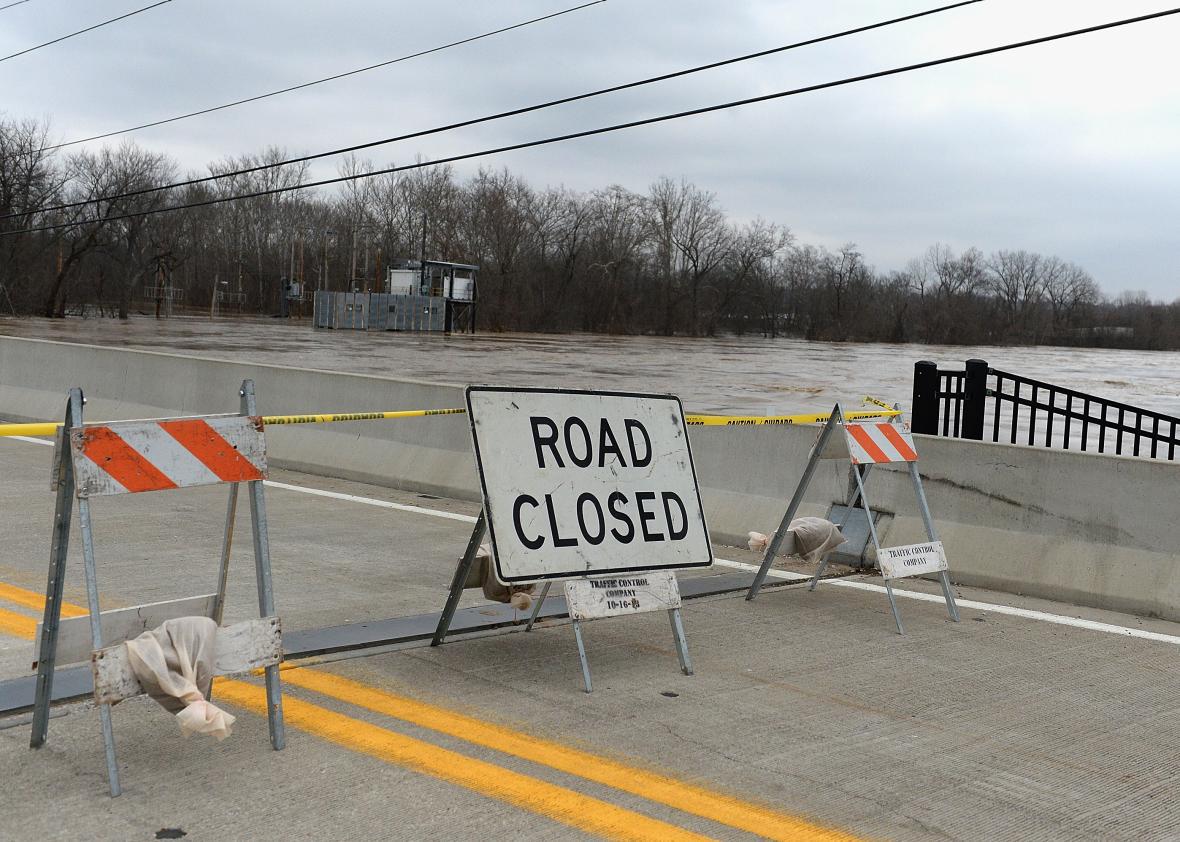This month is shaping up to be one of the most freakish in meteorological history. There’ve been tornadoes, blizzards, and a terrifying mid-winter heatwave that briefly pushed the pitch-black North Pole above the freezing point.
The most consequential of these disasters is still unfolding. In recent weeks, torrential rains across a broad section of the Midwest have led to a dire flooding emergency along the Mississippi River and throughout the region. Millions of people are under flood warnings in at least 13 states. The St. Louis Post-Dispatch, which is covering the story with a fleet of helicopters, is chronicling some breathtaking scenes.
A flood of this magnitude simply shouldn’t happen during the middle of winter. First, because the late December atmosphere is typically too cold to carry this much moisture. Second, ice upstream usually slows down the river’s flow. Mindblowingly warm temperatures this month, though, have created an environment suitable for floods that rival some of the largest summertime ones ever measured. What’s certain is that this flood event is completely out of season.
Though the record rainfall—which was two to six times the typical December amount—has largely subsided, river levels continue to rise as tributaries flow into larger streams—some of which are as high as 20 to 30 feet above flood stage. One levee in the St. Louis area was briefly overtopped on Tuesday, forcing a rushed evacuation of the river town of West Alton. Also, as Slate’s Rachel Gross notes, a man and a dog were rescued from the roof of a house floating down the Meramec River west of St. Louis.
The National Weather Service in St. Louis expects that flooding along parts of the Mississippi River further downstream will be “major to historic,” exceeding even the “Great Flood” of 1993. That flood, which peaked on August 1, caused damages estimated at $15 billion.
Missouri Gov. Jay Nixon declared a “massive flood fight” and activated the National Guard. Downstream, other leaders are beginning to prepare for waters that will take days or even weeks to arrive. In Louisiana, Gov. Bobby Jindal declared a pre-emptive state of emergency. The Ohio, Arkansas, Missouri, and Red Rivers are all in flood stage, and will converge there, and an emergency spillway might be opened to alleviate the pressure on New Orleans. On Wednesday, the U.S. Army Corps of Engineers, which is in charge of flood control on the river, said that if the water rises an additional one foot above forecasts, it may decide to blast a hole in a southern Missouri levee to allow some water to escape to alleviate pressure on communities downstream.
But the worst part about this flood is that nearly all the deaths so far—more than 20—have been from people intentionally driving into floodwaters. This is needlessly tragic and in theory preventable, but it’s also understandable. And there’s no easy solution.
Though the National Weather Service maintains a generally effective public awareness campaign built around the catchy “Turn Around Don’t Drown” slogan, the percentage of flood deaths in vehicles during this particular flood event is well above average. Floodwaters just one or two feet deep can float a car, and it’s generally impossible to see how deep the water is until you’re floating away. It’s a dumb and frequently fatal mistake, sure, but it could also happen to anyone, even people who know better—as this essay by a Houston Chronicle photographer shows. Earlier this year, she became trapped in floodwaters when the city racked up a foot of rain in less than a day. You just want to get home. You take unnecessary risks that seem minor. And then you’re dead.
Instead of driving into floodwaters, we could just as easily be talking about running a red light or texting while driving. Driving is one of the most dangerous things we do on a daily basis, but it’s also routine, so we underestimate the inherent risk. Then along comes an unprecedented mid-winter flood, and cognitive dissonance reigns.
Meteorologists and public safety experts have a tendency to blame the victim during situations like this, but it’s also human nature to think such a heartbreaking tragedy wouldn’t happen to you in the same situation.
